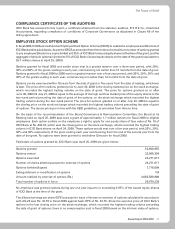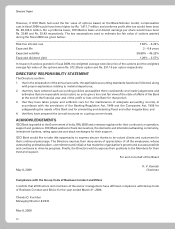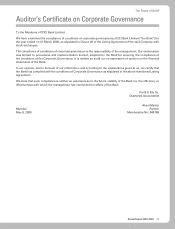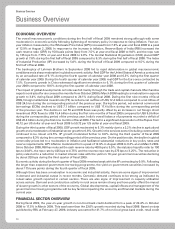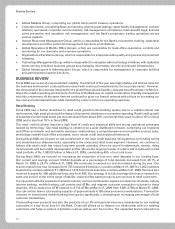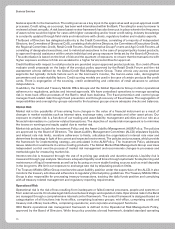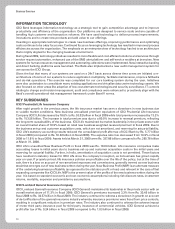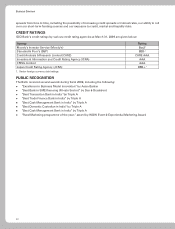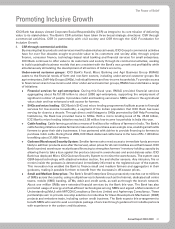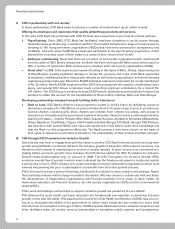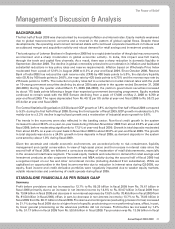ICICI Bank 2009 Annual Report Download - page 37
Download and view the complete annual report
Please find page 37 of the 2009 ICICI Bank annual report below. You can navigate through the pages in the report by either clicking on the pages listed below, or by using the keyword search tool below to find specific information within the annual report.
35Annual Report 2008-2009
The Power of Belief
Rural banking and agri-business
Rural India is the key to sustaining India’s current growth momentum and our rural banking strategy seeks to
match the growing demand for financial services in rural areas. The Rural, Micro Banking and Agri Business Group
(RMAG) has developed financing schemes that meet the needs of customers across the agriculture value chain.
We offer financial solutions to farmers, commodity traders & processors, SMEs & corporates in the agriculture
sector and microfinance institutions.
We have financed about 3.5 million low income customers in collaboration with micro finance institutions. It is
our endeavour to not only increase finance to this sector but also their ability to mitigate risks by offering micro
savings, investment and insurance products. We launched the Kisan Credit Card for providing adequate and
timely support to farmers under a single window with flexible and simplified procedures. Another key focus area
was to increase warehouse based finance to the farmer/small aggregator at the village level. To mitigate the risk
associated with financing small warehouses we use technology solutions to help monitor these warehouses and
thereby greatly increase the feasibility of financing small warehouses at the village level. We continued to finance
suppliers and vendors of corporates and medium enterprises engaged in agriculture linked businesses. We have
also increased our relationships with co-operatives that are constituted by farmers.
We have taken several initiatives to increase awareness among rural customers for enhancing credit penetration
in rural areas. We launched the “Kamdhenu - Cattle Loans Campaign” to reach out to cattle farmers. The campaign
received two marketing awards - the Rural Marketing Agencies India (RMAI) Award and the WOW Events &
Experiential Marketing Awards.
RISK MANAGEMENT
Risk is an integral part of the banking business and we aim at delivering superior shareholder value by achieving
an appropriate trade-off between risk and returns. The key risks are credit risk, market risk and operational risk.
Our risk management strategy is based on a clear understanding of various risks, disciplined risk assessment and
measurement procedures and continuous monitoring. The policies and procedures established for this purpose
are continuously benchmarked with international best practices.
The key principles underlying our risk management framework are as follows:
The Board of Directors has oversight on all the risks assumed by the Bank. Specific Committees of the
Board have been constituted to facilitate focused oversight of various risks. Our Risk Committee reviews
risk management policies in relation to various risks including portfolio, liquidity, interest rate, investment
policies and strategy, and regulatory and compliance issues in relation thereto. Our Credit Committee reviews
developments in key industrial sectors and our exposure to these sectors as well as to large borrower accounts.
Our Audit Committee provides direction to and also monitors the quality of the internal audit function. Our
Asset Liability Management Committee is responsible for managing the balance sheet and reviewing our
asset-liability position.
Policies approved from time to time by the Board of Directors/Committees of the Board form the governing
framework for each type of risk. The business activities are undertaken within this policy framework.
We have dedicated groups viz. Global Risk Management Group (GRMG), Compliance Group, Corporate Legal Group,
Internal Audit Group and the Financial Crime Prevention and Reputation Risk Management Group (FCPRRMG),
with a mandate to identify, assess and monitor all of the Bank’s principal risks in accordance with well-defined
policies and procedures. GRMG is further organised into the Global Credit Risk Management Group, the Global
Market Risk Management Group and the Operational Risk Management Group. These groups are completely
independent of all business operations and coordinate with representatives of the business units to implement
ICICI Bank’s risk management methodologies. The Internal Audit and Compliance groups are responsible to the
Audit Committee of the Board.
Credit Risk
Credit risk is the risk that a borrower is unable to meet its financial obligations to the lender. All credit risk related
aspects within the Bank are governed by the Credit and Recovery Policy (Credit Policy). The Credit Policy outlines
the type of products that can be offered, customer categories, target customer profile, credit approval process
and limits. The Credit Policy is approved by the Board of Directors.
We measure, monitor and manage credit risk for each borrower and also at the portfolio level. In order to assess
the credit risk associated with any financing proposal, we assess a variety of risks relating to the borrower and
the relevant industry. We have a structured and standardised credit approval process which includes a well-
established procedure of comprehensive credit appraisal and credit rating. We have developed internal credit rating
methodologies for rating obligors. The rating factors in quantitative and qualitative issues and credit enhancement




